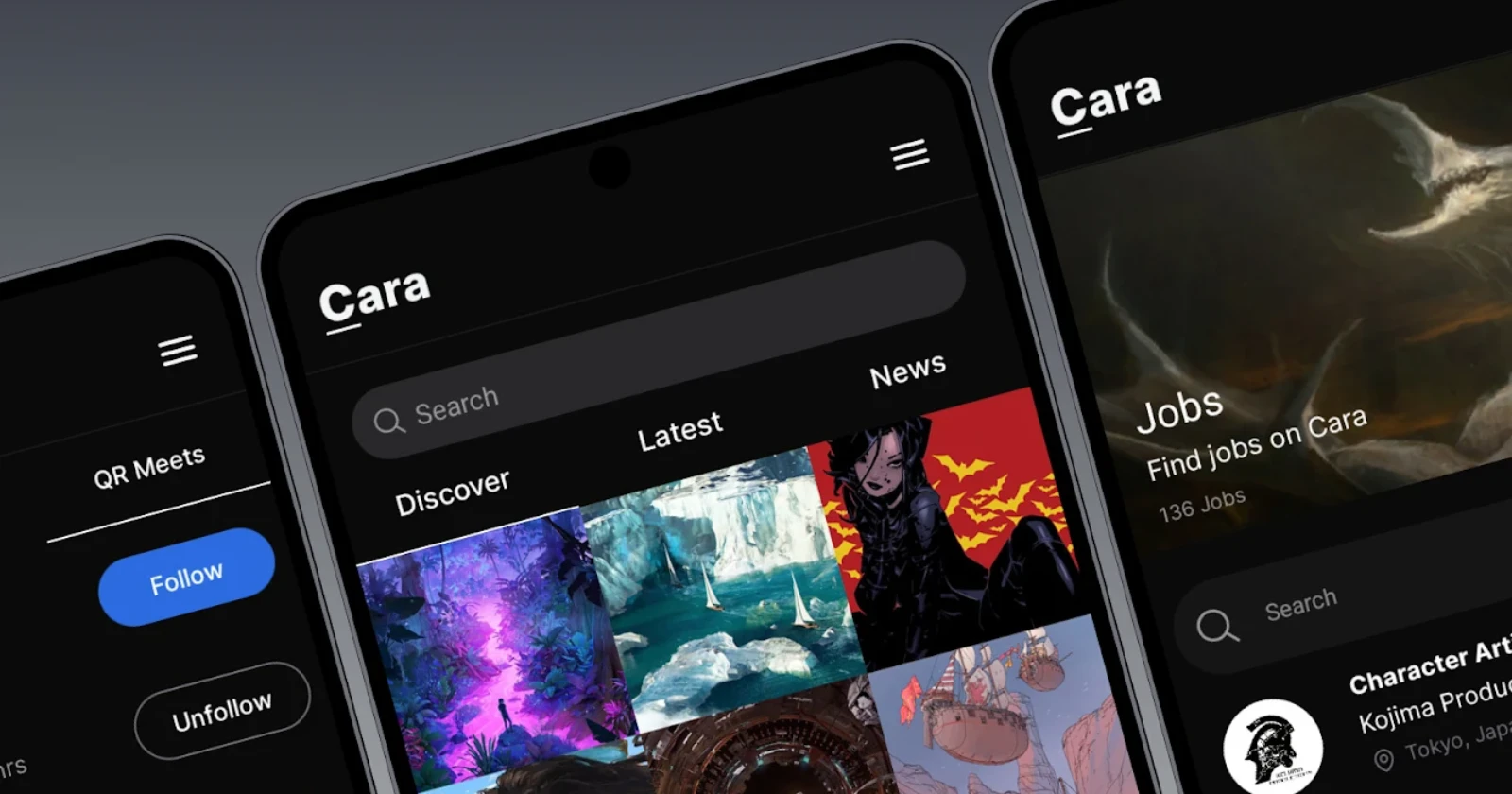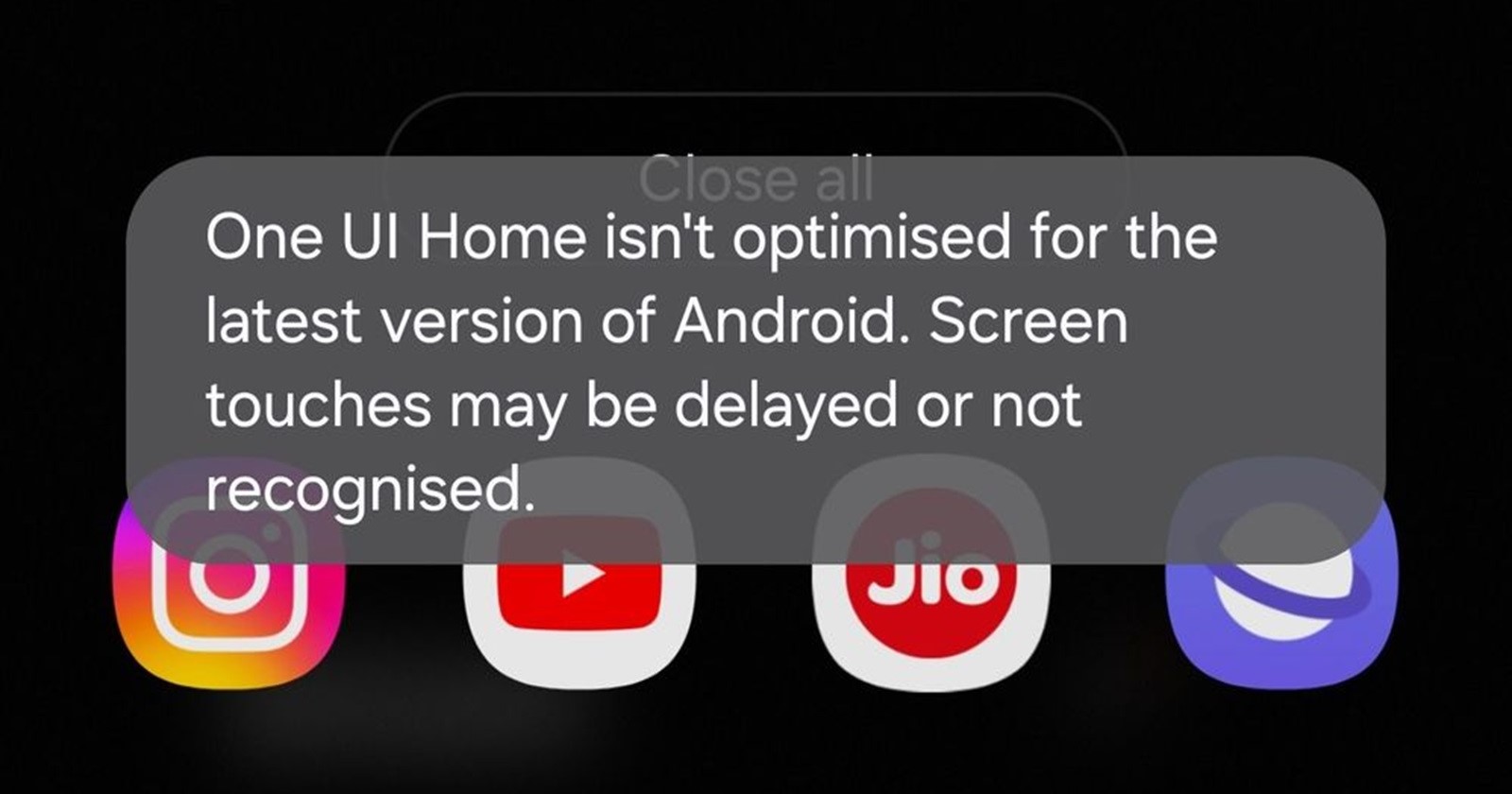Hi!! We have almost 800k users on Cara so it's time for another quick update!!—
— Jingna Zhang @ cara.app/zemotion (@zemotion) June 9, 2024
1. Team and I are heads down dealing with infra, speaking with vendors, and doing everything we can to make sure Cara keeps going. 1/
In the ever-evolving landscape of social media, a new player has emerged, capturing the attention of artists worldwide. Cara, an app designed with artists in mind, has seen a meteoric rise in popularity, amassing nearly 600,000 users within a week. At the time of writing, Cara now has close to 800K users. This surge is largely due to a mass exodus of artists from Instagram, a platform they once relied on for visibility and income. But what triggered this migration, and is Cara truly the answer to artists’ woes? Let’s delve into the reasons behind this shift and evaluate the potential of this new platform.
The AI conundrum: Instagram’s betrayal of artists
At the heart of the artist exodus lies a fundamental disagreement with Instagram’s parent company, Meta, over its handling of AI. In May, a Meta executive revealed that the company considers public Instagram posts part of its AI training data. This announcement was followed by a notification to users in Europe that their posts would be used to train AI starting June 26, with a complex way to opt-out.
This policy has enraged artists, who see it as a betrayal. Many feel that Meta is exploiting their work without consent or compensation. The irony is palpable: the very platform artists used to build their careers is now using their content to train AI models that could potentially replace them.
“Words can’t describe how dehumanizing it is to see my name used 20,000+ times in MidJourney,” lamented photographer and Cara founder Jingna Zhang on Instagram. “My life’s work and who I am—reduced to meaningless fodder for a commercial image slot machine.”
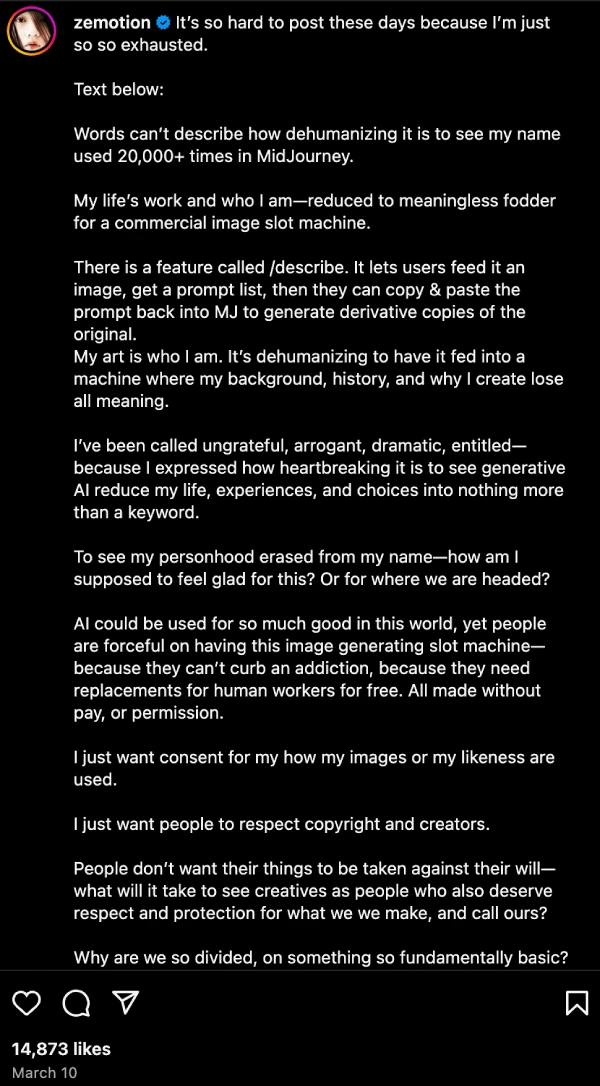
The AI issue isn’t just about Meta. Many artists are suing AI companies like Google, Stability AI, Midjourney, and DeviantArt for training on their copyrighted work without permission. These lawsuits argue that the companies’ actions don’t fall under “fair use” laws, which allow for remixes and interpretations of existing content.
This tension is part of a larger debate about AI’s impact on creative industries. As photographer and artist rights advocate Zhang pointed out in a recent interview with TechCrunch, “For artists, it’s a part of our selves and our identity. I would not want my best friend to make a manipulation of my work without asking me. There’s a nuance to how we see things, but I don’t think people understand that the art we do is not a product.”
Enter Cara: A safe haven for artists?
In the midst of this tumult, Cara has emerged as a beacon of hope. The app, which launched in January 2023, is explicitly anti-AI. It bans AI-generated images and uses detection technology from AI company Hive to weed out rule-breakers. Each uploaded image is tagged with a “NoAI” label to discourage scraping. Here’s Cara’s stance on AI:
– We do not agree with generative AI tools in their current unethical form, and we won’t host AI-generated portfolios unless the rampant ethical and data privacy issues around datasets are resolved via regulation.
– In the event that legislation is passed to clearly protect artists, we believe that AI-generated content should always be clearly labeled, because the public should always be able to search for human-made art and media easily.
Cara’s strict guidelines on AI is just one part of its appeal. Most articles describe the app as designed as a hybrid of Instagram and X, with a portfolio section on each profile that’s separate from the regular feed. However, after using the app, I’d say UI looks inspired from Instagram and Threads, to be precise. This structure allows artists to showcase their best work while also engaging in more casual, X-like conversations.
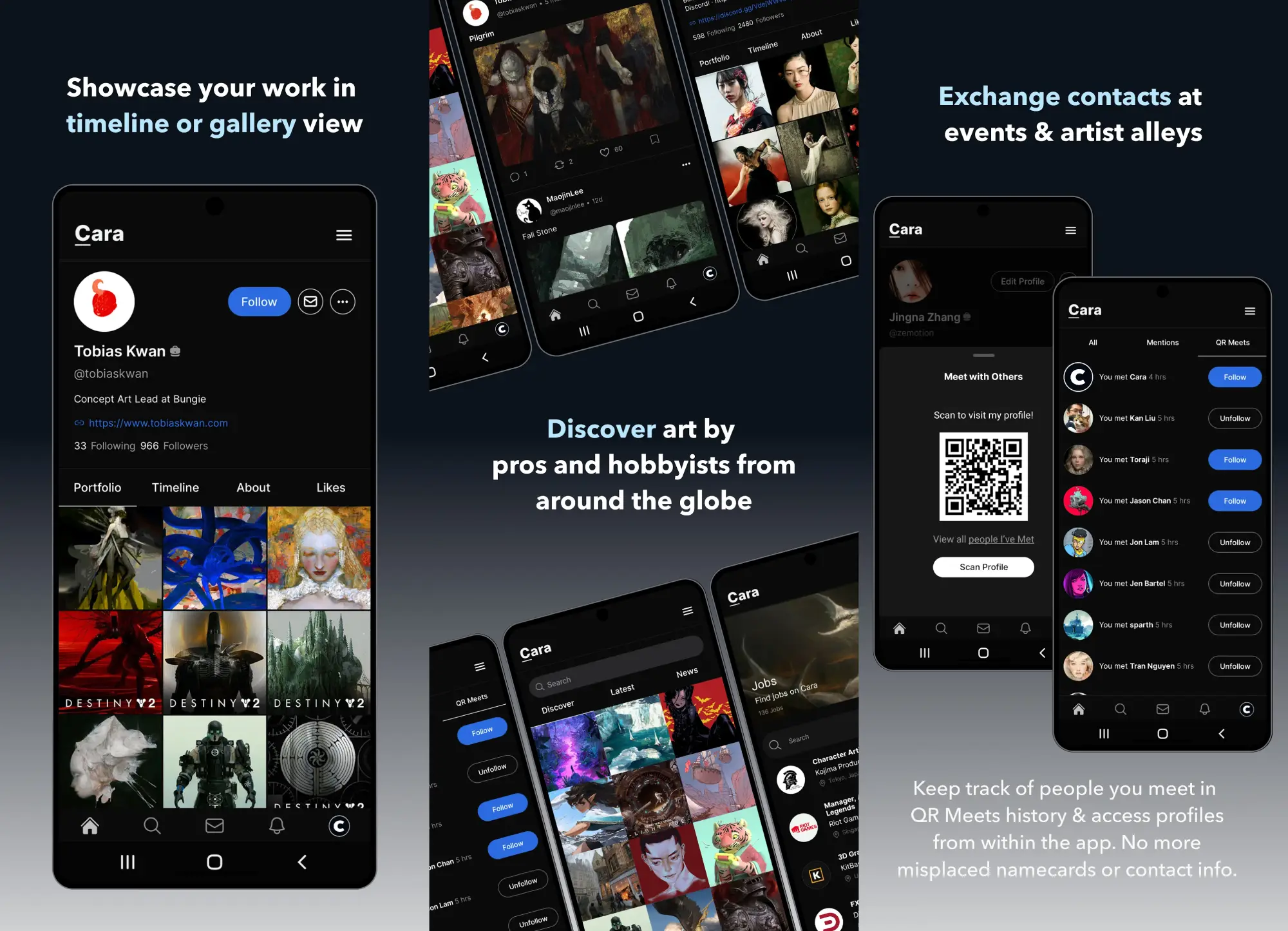
“I think it’s experience and maturity,” Zhang told TechCrunch, reflecting on her journey from professional Go player to photographer to tech founder. “For me, I was a national athlete for Singapore and then a photographer, and both times I have done really well in the specific fields I’ve chosen, but they’re very individually driven — you just have to be very, very good yourself. Let’s say, my teamwork was not the best.”
But building a tech company requires teamwork, and Zhang has assembled a dedicated group, many of whom are volunteers. This commitment to the cause is one reason artists feel they can trust Cara.
The platform also recognizes the professional needs of artists. Cara integrates job listings from AAA and award-winning studios, allowing artists to discover and apply for opportunities directly through the platform. This eliminates the need for them to scour different websites or rely on third-party job boards. Cara essentially streamlines the process of connecting talented artists with potential employers.
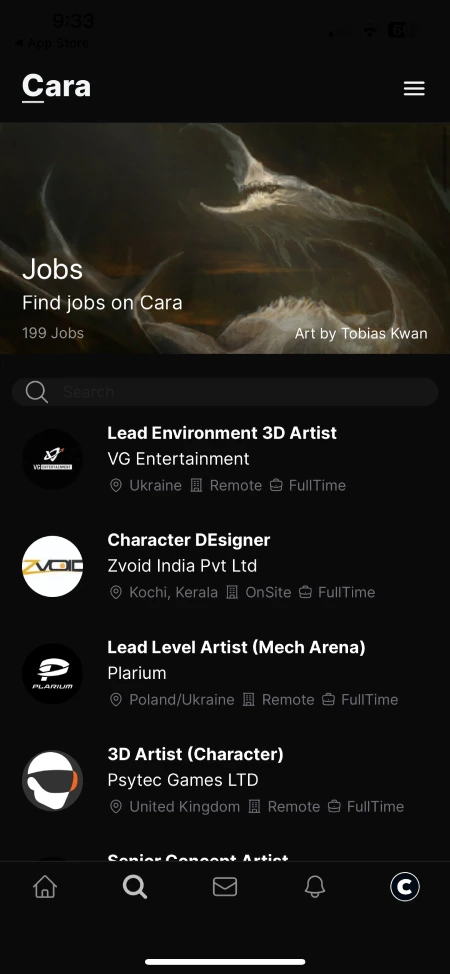
Finally, according to Cara’s privacy policy, the platform collects very limited personal information from users. They only collect non-personal information like your browser type, device information and IP address to improve your experience on the platform. If you sign up for their online community, they may collect information about the people you connect with and how you interact with them on the platform. They may also request your phone number for verification purposes but will not store it. Cara assures users that their information is not sold or leased to any third party. They will use the information you provide to improve their products and services. You can always opt out of receiving emails from them by following the instructions included in the email. Users can also request to access or delete their personal information at any time by contacting Cara via email.
Growing pains and financial challenges
Cara’s rapid growth hasn’t come without issues. Many users report that the app is buggy, slow, or even inaccessible at times. This is unsurprising given that the app’s user base exploded from about 40,000 to 650,000 in just a week. Having used Cara extensively on an iOS device, I noticed random slowdowns or horizontal swipes acting iffy when trying to swipe between the ‘Home’ and ‘Following’ tabs.
Zhang has been transparent about these challenges. In a recent X thread, she wrote, “Team and I are heads down dealing with infra, speaking with vendors, and doing everything we can to make sure Cara keeps going… We’re fixing as many bugs as we can, but sometimes in development, more bugs are introduced as things are getting fixed.”
Luckily, the developers are transparent about the bugs and issues that they know about and are working to fix. The website has a dedicated page for the site’s status and known issues for users to check out.
Apart from having to deal with the technical issues, the financial strain is significant. Zhang shared that her server costs jumped from $2,000 to $13,500 in a week. To offset this, Cara has introduced a “buy me a coffee” feature, where users can donate small amounts to support the platform. However, Zhang is adamant that no one should feel pressured to contribute: “I remember walking 30 minutes to save 10 cents for bread when I was younger, so I feel very deeply about how a coffee isn’t ‘just a coffee’ for many.”
This financial pressure raises questions about Cara’s long-term sustainability. As one Reddit user, FaintestGem, pointed out: “With how much emphasis everyone is putting on AI… yeah, I imagine finding the one guy that wants to bet on the complete opposite is going to be difficult.”
The user experience: A return to art-centric social media
Many artists report that using Cara feels like a breath of fresh air after the chaos of Instagram. The app’s minimalist design and focus on art are reminiscent of early Instagram, before it became the algorithmic hydra it is today.
Digital artist Melissa Vandiver said, “I’m personally getting the most value out of just being able to look at art and interface with artists outside of the environment of selling and gaming the algorithm. It’s kind of mind-blowing how much more art I’ve seen there than IG when I basically only follow artists on IG.”
This sentiment is echoed by illustrator defsiarte: “I missed having a website where my feed was all art. I think that people who saw it as an Instagram alternative or traditional social media misunderstood the platform, it feels like a portfolio or networking site. Very akin to ArtStation, or even LinkedIn.”
The sense of community on Cara is also striking. Artist aerohail noted, “People seem more willing to comment on each others art and the community vibes are super nostalgic to back how art communities used to be imo.”
This hearkens back to platforms like DeviantArt in its heyday, where the focus was purely on art and fostering community among artists. It’s a stark contrast to Instagram, where artists compete not just with each other, but with influencers, brands, and an algorithm that often favors video content over static images.
The challenge of attracting non-artists
While Cara is thriving as an artist-centric platform, some users worry that its niche focus might limit its effectiveness as a place to find new clients or sell art.
As Reddit user Legitimate-Drawer246 bluntly put it: “My thoughts on it are that it’s for artists to jerk off other artists. I mean, I get that meta’s AI policy is BS, but your everyday peeps won’t be going over to Cara. People like Instagram because it has all their favorite things, artists, local restaurants, bands, etc.”
This is a valid concern. Instagram’s appeal lies in its broad user base – it’s not just a place to see art, but to follow friends, celebrities, brands, and more. This diversity means that non-artists often stumble upon and fall in love with art they might never have seen otherwise. This sentiment was also echoed by Christina Kent, an artist and YouTuber, who recently posted a video discussing how Cara stacks up to Instagram:
Concept designer and illustrator Hicham Habchi (with 122.3K followers on X) and South Korean illustrator WAGO (with 258K followers on X) are among many of the popular artists who have joined Cara. Their presence could draw in fans, but it remains to be seen whether the average Instagram user will make the switch.
At present, Cara offers absolutely nothing for non-artists to consider joining the platform. Don’t get me wrong! I’m sure hardcore fans of artists will definately make their way over to the app to show support, but the average Joe like me has no incentive to use the app. Therefore, as things stand, Cara is a niche social media app for artists.
Another thing to note is that while the BIG numbers of users that seem to be joining Cara might be exciting, I’m not sure if most of the enthusiastic users will stick around for long. For instance, Instagram’s Threads app saw a massive influx of users when it launched, but it then struggled to retain those users.
Clearing up misconceptions and rumors
In a recent thread on X, the platform clarified rumors that had many users worried. The first major concern was about copyright. Cara clarifies that their terms of service only grant them permission to display your artwork on the platform. They can resize or crop the images for better presentation, but they don’t claim ownership of your work and won’t sell it. This means you retain your copyright and can control how your work is used elsewhere.
Another concern was about Cara’s connection to AI (Artificial Intelligence). Cara assures users that they don’t train any AI models on user data. They also have a partnership with another company called Hive AI, but that partnership is specifically to identify and remove AI-generated images from Cara, not to train them.
Finally, the tweets address rumors about Cara’s founder. They claim that the founder, Zhang, is a strong advocate for artist copyright and actually opposes unethical practices in AI art generation. They even mention that she is actively fighting for artist rights by being a lead plaintiff in lawsuits against AI companies. This paints a picture of a founder who is aligned with the interests of artists and is committed to protecting their rights.
Other alternatives worth checking out
Given the fact that Cara is still in its infancy and is far from perfect, it would not be a wise decision to put all your eggs in one basket. I’ve rounded up a few other great alternatives to showcase your creativity. But you must also keep in mind that these platforms don’t have strict guidelines on AI content, at least nowhere close to Cara.
1. DeviantArt
DeviantArt is a longstanding online community for artists of all stripes. It offers a robust platform for showcasing your work, following other artists, and building a fanbase. DeviantArt features a forum system where artists can connect and give each other feedback. The platform also allows users to customize their profiles extensively, making them a true representation of their artistic brand. While DeviantArt may skew slightly more towards younger demographics, it’s a great place to find a supportive community and get your work seen.
2. Behance
Behance is a portfolio platform specifically designed for creative professionals. It’s a great platform to showcase your work to potential clients and employers. Behance integrates with Adobe Creative Suite, making it easy to upload your projects. The platform also allows users to curate mood boards and follow other creatives for inspiration. However, Behance may not be the best platform for building a social following, as it’s more focused on professional networking.
3. ArtStation
ArtStation is another portfolio platform geared towards concept artists, illustrators, and other professionals in the gaming and entertainment industries. It offers a sleek, minimalist interface that puts your artwork front and center. ArtStation also features a jobs board where artists can find freelance and full-time work. However, like Behance, ArtStation is more focused on professional networking and may not be the best platform for building a social following.
4. Pixiv
Pixiv is a popular Japanese social media platform for artists. While the platform is primarily in Japanese, it still has a large international user base. Pixiv is a great place to discover new artists and see different styles of art. The platform also features a vibrant community where artists can share their work and give each other feedback. However, navigating Pixiv can be challenging if you don’t speak Japanese.
The verdict: A promising start, but challenges ahead
So, is Cara the answer to artists’ Instagram woes? The answer is nuanced.
In terms of providing a safe, AI-free space for artists to showcase their work and connect with peers, Cara is excelling. The community vibes, the focus on art, and the commitment to keeping AI at bay are all major pluses. For artists burned out by Instagram’s chaos and betrayed by its AI policies, Cara is a refreshing change.
However, the app faces significant challenges. The technical issues, while understandable given the rapid growth, need to be resolved quickly to retain users. More critically, the financial model is unsustainable. Relying on donations won’t cut it in the long run, but introducing ads or a paid tier could alienate users.
The biggest question mark, though, is whether Cara can attract a broader audience. While it’s great for artists to connect with each other, most need to reach non-artists to make a living. If Cara remains an artist-only enclave, its utility for selling art and finding new clients may be limited. Despite these challenges, the overwhelming sentiment among artists is one of hope and determination. As Zhang wrote on X: “I decided to build Cara and I will do all I can in my power to make it work. If you’d like to help, please respect the work our team and I have been doing, have faith in me, and be kind and supportive to one another.”
In conclusion, Cara represents a valiant attempt to give artists what they desperately need: a platform that respects their rights and understands their needs. It’s off to a promising start, but its long-term success will depend on overcoming significant technical, financial, and market challenges. For now, it seems wise for artists to embrace Cara without abandoning other platforms entirely. As user Disastrous_Studio230 put it: “I am not migrating to it away from Meta platforms. I am adding it to the platforms I use instead.”
In the end, the rise of Cara is about more than just one app. It’s a statement by artists that they will not quietly accept being exploited by the very platforms they helped build. Whether Cara thrives or fades, it has already made a powerful point: in the age of AI, artists’ rights matter more than ever.

